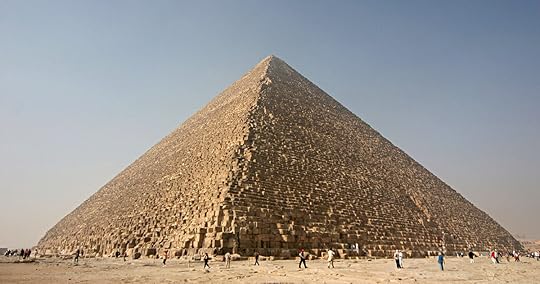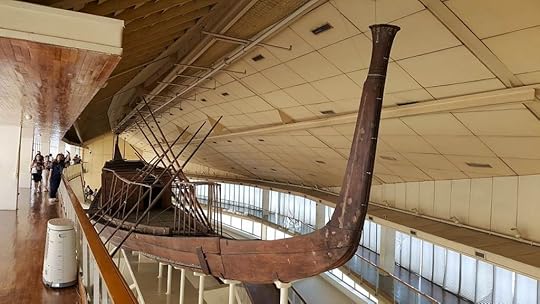Ripley Entertainment Inc.'s Blog, page 96
March 23, 2022
Mummy Brown: The Paint Color Made From Actual Human Corpses
Featured in Ripley's Believe It or Not!

Nowadays, if you want to see a mummy, your best choice is to go to a museum. But for a while, Egyptian mummies were so common that Europeans figured out how to use them in a number of unusual — and often very creepy — ways.
A Mummy a Day…Between the 12th and the 17th centuries, mumia (basically the dust of ground up mummies) was a common cure-all preparation used to treat anything from wounds to a cough to “pains of the spleen.” This practice got even creepier during Victorian times, when mummy powder was sometimes mixed with alcohol or chocolate before being consumed as medicine.

A man selling Egyptian mummies in 1875 and an apothecary vessel once used for storing “mumia”
The reason mummies were believed to have healing properties? Turns out it was because of their color. Bitumen from the Dead Sea has been used for medicinal purposes for thousands of years. At the time, Europeans believed the dark-colored substance was what caused the blackened appearance of some mummies — which bring us to the creation of “mummy brown.”
Color Me SurprisedProduced by mixing powdered mummy flesh with myrrh and white pitch (a polymer), “mummy brown” was a very popular paint color in the 16th and 17th centuries. There was something about the mummies that provided a rich, warm pigment painters quickly came to love.
The paint had good transparency, which meant it was very versatile. It was possible to use it as an oil paint but also for glazing and shading. As a rich but lighter burnt umber color, it also provided the perfect color for painting, coincidentally, flesh tones.

Harvard Art Museums/Straus Center for Conservation and Technical Studies, Forbes Pigment Collection
Burying the PastOne of the biggest issues with mummy brown is that it was quite unreliable as a paint. As every mummy was different, so was the quality of the final paint color — sometimes the color would crack easily, sometimes it would dry poorly or be affected easily by air or sunlight.
Many painters stopped using it for these reasons, and this was even before they knew what mummy brown was actually made of! The story goes that English painter Edward Burne-Jones was so shocked when he found out the paint actually contained human remains, that he buried his last tube of the paint in his garden.

The Last Sleep of Arthur in Avalon (1880s) by Edward Burne-Jones. Did he use mummy brown to paint it?
Still, the production of mummy brown only ended in the mid-1960s — and only because the company making the color simply ran out of mummies. As the managing director of the color-making company C. Roberson told TIME magazine, “We might have a few odd limbs lying around somewhere, but not enough to make any more paint.”
By Diana Bocco, contributor for Ripleys.com
EXPLORE THE ODD IN PERSON! Discover hundreds of strange and unusual artifacts and get hands-on with unbelievable interactives when you visit a Ripley’s Odditorium!Source: Mummy Brown: The Paint Color Made From Actual Human Corpses
CARTOON 03-23-2022
March 22, 2022
Fridge-Size Asteroid Spotted Two Hours Before Hitting Earth
Featured in Ripley's Believe It or Not!

Whether we’re talking 1979’s Meteor or 1998’s Armageddon, stories about Earth-smashing asteroids are nothing new to Hollywood. They usually get detected early enough by scientists so that the most important characters can get in some great one-liners before averting universal crisis. Sometimes the plot involves known enemies pulling together, as is the case with the USSR and the USA in Meteor. And others, like Armageddon, depict heroism from unlikely sources, keeping the planet from getting smashed to smithereens. Of course, there’s also plenty of science-defying action in the name of entertainment.
But the reality of asteroids is different. According to Live Science, just five asteroids have been detected before hitting the blue planet. In other words, most of these space rocks collide with our world without giving us much, if any, warning. Recently, a refrigerator-size asteroid collided with our planet, and scientists only had a two-hour warning window. Here’s the story behind its detection.
Coming in HotHungary’s Konkoly Observatory buzzed with life after astronomer Krisztián Sárneczky detected 2022 EB5 at its Piszkéstető Mountain Station on March 11, 2022. The Observatory alerted authorities, and soon NASA’s “Scout” impact hazard assessment system kicked in to monitor the fast-moving rock. Once Scout determined unequivocally that the meteor was inbound, it sent a warning to the Center for Near Earth Object Studies (CNEOS) at California’s NASA Jet Propulsion Laboratory (JPL). The CNEOS team went to working predicting the time and location of the asteroid’s impact, according to the JPL.
Davide Farnocchia of the JPL explains, “Scout had only 14 observations over 40 minutes from one observatory to work with when it first identified the object as an impactor. We were able to determine the possible impact locations … As more observatories tracked the asteroid, our calculations of its trajectory and impact location became more precise.” Like silver screen depictions of such an event, it required an international effort to track and pinpoint the object before it hit.
https://d2pn8kiwq2w21t.cloudfront.net/media/1_PIA24568_EB5-heliocentric-clipped-zoom-for-JPL.m4vCredit: NASA/JPL-Caltech
Accurately Predicting the HitJust 120 minutes later, the asteroid collided with the planet traveling at speeds in excess of 39,600 miles per hour. Measuring 6.5 feet wide, it exploded coming into Earth’s atmosphere. Based on its estimated speed, scientists calculated that the rock was approximately one-third of the distance between the moon and the Earth when eagle-eyed Sárneczky first saw it.
Amazingly, Scout showed 2022 EB5 hitting the Earth’s atmosphere over the Norwegian island of Jan Mayen, located 300 miles away from Greenland at roughly 5:23 p.m. EST, and it did precisely that. Researchers corroborated the accuracy of Scout using infrasound detectors to confirm the impact point. These detectors also made it possible to accurately record the size of the asteroid.
Why Small Asteroids Are a Challenge to PinpointAt this point, you may be wondering how often events like this take place. According to Director Paul Chodas of the CNEOS, “Tiny asteroids like 2022 EB5 are numerous, and they impact into the atmosphere quite frequently — roughly every ten months or so.” If impacts from such asteroids prove so common, why is 2022 EB5 only the fifth asteroid ever detected beforehand?
Small asteroids appear faint in the night sky, and the odds of pointing a survey telescope in the right spot at the right time are astronomically low — literally! But a couple of hours before entering Earth’s orbit, these objects brighten up. This final “lighting up” is what tipped Sárneczky off.
Fortunately, astronomers can detect larger asteroids earlier because they’re easier to see. For example, the first asteroid ever identified before impact was 2008 TC3, a 13-foot-wide asteroid that impacted the planet over the Nubian Desert. As it came into the Earth’s protective atmosphere, it shattered, sending a hail of smaller meteorites across the desert. So, Hollywood did get it right when it comes to seeing ginormous meteors ahead of time. Just don’t expect NASA to call in Bruce Willis to save the planet (twice)!
By Engrid Barnett, contributor for Ripleys.com
EXPLORE THE ODD IN PERSON! Discover hundreds of strange and unusual artifacts and get hands-on with unbelievable interactives when you visit a Ripley’s Odditorium!Source: Fridge-Size Asteroid Spotted Two Hours Before Hitting Earth
CARTOON 03-22-2022
March 21, 2022
The Great Government Free Cheese Movement
Featured in Ripley's Believe It or Not!

What comes to mind when you hear the term “government cheese”? If you’re a child of the 1980s, it likely involves recollections of a salty, pale-orange substance that came in five-pound blocks. Some might describe it as the unfortunate (and moldy) offspring of American cheese and Velveeta. Meted out to low-income families and the elderly, it helped people muscle through difficult economic times. And a whole generation of children grew up on the stuff.
The strange and sordid tale of dairy gone wrong starts in 1949 with the Agricultural Act, which granted the Commodity Credit Corporation (CCC) authority to subsidize dairy farmers by purchasing their excess goods. The CCC received this power to help stabilize farm incomes during times of economic challenge. But getting this right proved more complicated than officials anticipated, and it would lead to a nearly unpalatable solution.
Here’s what you need to know about the free cheese movement and why it left a bad taste in many people’s mouths.
Too Much Disco, Not Enough DairyThe 1970s represented a mixed bag in America. On the one hand, this decade gave the world disco and Queen, but it also came with long gas lines, the Great Inflation, and the Iranian Hostage Crisis. And if that wasn’t enough, the decade also saw a drastic dairy shortage, resulting in price increases of 30 percent. This led to government intervention and $2 billion in subsidies awarded to dairy farmers over a four-year time span.
Suddenly, the government became the largest consumer of the nation’s dairy supply. This raised an important question: What to do with all that creamy goodness? Soon, the Feds got into the business of butter churning, powdered milk making, and cheese processing. Before long, the nation’s stockpile of dairy products had ballooned out of control, with stores holding more than 500 million pounds in warehouses spread across 35 states, per the Farm Link Project.
Embed from Getty Imageswindow.gie=window.gie||function(c){(gie.q=gie.q||[]).push(c)};gie(function(){gie.widgets.load({id:'Ve2jTpzdStNuxdqTB5lKoA',sig:'RIN2tl959D7hRSxPqahLnUJT-O92jCqs95uciA7c_Q0=',w:'594px',h:'402px',items:'516579276',caption: false ,tld:'com',is360: false })});
New Decade, Old CheeseBy the early 1980s, the moldering cheese problem reached a breaking point in the United States. In a Washington Post article from 1981, a USDA official diplomatically suggested that the most cost-effective solution to the dairy deluge would be to “dump [the government cheese] in the ocean.” Anxiety ratcheted up with each passing year because no one knew how long the shelf life on those pungent blocks might be.
The crisis reached its stinkiest moment when former U.S. Secretary of Agriculture John R. Block brought a five-pound chunk of government cheese to the White House. Holding it aloft as he spoke to the press, he declared, “We’ve got 60 million of these that the government owns. It’s moldy, deteriorating … we can’t find a market for it, we can’t sell it, and we’re looking to try to give some of it away.” The war cry delivered; Americans stepped up to do their part. Soon, millions of pounds of cheese got distributed to the elderly, low-income families, and organizations who served them.
The Hard Times CheeseThe people who received “government cheese” had varied responses. Some appreciated the extra help, while others saw it as socioeconomically stigmatizing. As for the palatability of the five-pound blocks, the verdict remained out. To this day, most people that ate it remember the strong odor and the savory flavor. Some recollect its odd texture, which made it less than desirable for snacking. But it lent itself well to grilled cheese sandwiches and macaroni and cheese.
Embed from Getty Imageswindow.gie=window.gie||function(c){(gie.q=gie.q||[]).push(c)};gie(function(){gie.widgets.load({id:'H57pqq55SQJ_jwqPYR1tOg',sig:'n-0XtGSMQnyYbgQ7jBIUgF87TtEPPmHYsfj0R5K_YZI=',w:'594px',h:'405px',items:'516513124,516506318',caption: true ,tld:'com',is360: false })});
Fortunately, the Federal government exited the cheese-making industry in the 1990s, and most people who consumed “government cheese” unanimously said “Good riddance.” But those who grew up on the substance do hold some fond memories of it. For a handful, it even came to represent a type of comfort food. Tracey Lynn Lloyd, a food writer, concludes, “If someone made me a grilled cheese with government cheese today, I probably couldn’t eat it … But I’d still take one bite, just for the memories.”
By Engrid Barnett, contributor for Ripleys.com
EXPLORE THE ODD IN PERSON! Discover hundreds of strange and unusual artifacts and get hands-on with unbelievable interactives when you visit a Ripley’s Odditorium!CARTOON 03-21-2022
March 20, 2022
CARTOON 03-20-2022
March 19, 2022
CARTOON 03-19-2022
March 18, 2022
Cosmic Scans Detect Mysterious Tunnels Hiding In Great Pyramid Of Giza
Featured in Ripley's Believe It or Not!

After 4,500 years, the Great Pyramid of Giza is still revealing secrets from within, as advanced cosmic ray technology has revealed two mysterious tunnels within the pyramid walls, one of which may lead to a secret burial chamber!
Cosmic Rays with Tunnel VisionArchaeologists from the University of Cornell did a deep dive in to a series of scans captured as part of the ScanPyramids project between 2015 and 2017 in which cosmic rays were used to detect voids by analyzing “muons” — high-energy particles that constantly fall on Earth.
Muons are the key to unveiling more details about the pyramid, as they behave differently on stone and air, allowing researchers to use powerful detectors to map out air pockets in stone structures.
As noted in the follow-up study published on arXiv, the scans helped map the Great Pyramid’s structure, identifying two voids in the process — a small one near the north face and a much larger passageway located above the grand gallery.
While the function of both tunnels remains unclear, the larger of the two, which is about 98 feet long and 20 feet high, could potentially be the opening to the hidden burial chamber of Pharaoh Khufu, for whom the pyramid was built.

Previously known chambers of the Great Pyramid. (Jeff Dahl via Wikimedia Commons CC BY-SA 4.0)
Pharaoh Khufu’s Greatest ContributionsErected in the 26th century BC, the Great Pyramid of Giza is the last surviving wonder of the ancient world and was the largest pyramid ever constructed in ancient Egypt at 455 feet tall. In fact, it was the tallest building in the world for 3,800 years!
Pharaoh Khufu, also known by his Greek name Cheops, commissioned the pyramid upon ascending the throne in 2551 BC. The second Pharaoh of the Fourth Dynasty, Khufu ruled for at least 26 years, during 23 of which he oversaw the building of his massive legacy.
There is still a lot of mystery behind the pyramid’s construction, but Egyptologists believe it took around 20,000 Egyptians and 5.5 million tons of limestone to get the job done.
The Great Pyramid isn’t Khufu’s only contribution to Egyptian history. In 1954, the Khufu ship was discovered sealed in a pit at the foot of the Great Pyramid. The 143-foot-long ship was presumably built for the Pharaoh in his afterlife and is one of the largest and best-preserved vessels from ancient times.

The reconstructed Khufu ship. (Ovedc via Wikimedia Commons CC BY-SA 4.0)
Supercharged Scan PlansResearchers hope to get a glimpse inside the voids using a telescope system with 100 times the sensitivity of those used in the Scan Pyramids project.
These supercharged cosmic rays will capture muons from “nearly all angles,” allowing researchers to analyze energy waves detailed enough to produce a high-resolution 3D image.
Detectors of this magnitude are not tiny enough to place inside the pyramid, so they’ll have to be placed outside and moved along the base to build the data set. The extreme sensitivity of the scanners could potentially be so strong they may be able to detect pottery and other artifacts housed within the newfound tunnels.
Though the scans have been green-lit by the Egyptian Ministry of Tourism and Antiquities, there is still a large amount of funding needed to build and deploy the powerful equipment necessary to complete the project, which will take two to three years to finish.
Currently, the group has enough funding to conduct simulations and design prototypes, but they’re actively looking for sponsors to help finally reveal what lies beyond the Great Pyramid of Giza’s walls.
By Meghan Yani, contributor for Ripleys.com
EXPLORE THE ODD IN PERSON! Discover hundreds of strange and unusual artifacts and get hands-on with unbelievable interactives when you visit a Ripley’s Odditorium!Source: Cosmic Scans Detect Mysterious Tunnels Hiding In Great Pyramid Of Giza
CARTOON 03-18-2022
Ripley Entertainment Inc.'s Blog
- Ripley Entertainment Inc.'s profile
- 52 followers









